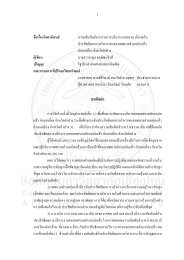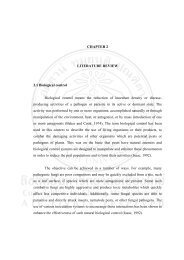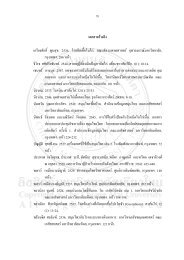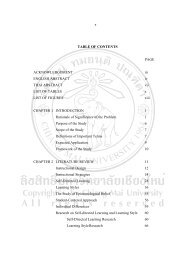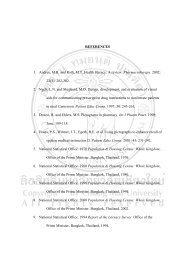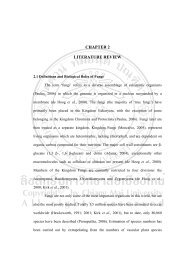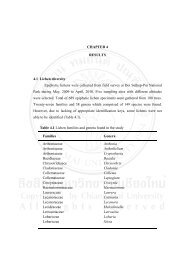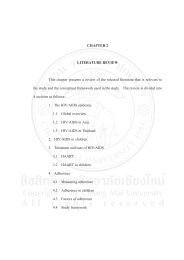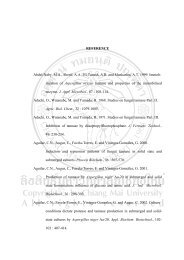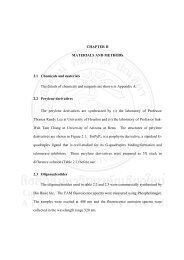prevalence and molecular characteristics of vibrio species in pre ...
prevalence and molecular characteristics of vibrio species in pre ...
prevalence and molecular characteristics of vibrio species in pre ...
You also want an ePaper? Increase the reach of your titles
YUMPU automatically turns print PDFs into web optimized ePapers that Google loves.
28<br />
genes by DNA based <strong>molecular</strong> techniques such as PCR <strong>and</strong> colony hybridization<br />
methods are more important. Researchers found the PCR method as a more reliable,<br />
rapid <strong>and</strong> sensitive method compare to conventional microbiological assays (Bej et<br />
al., 1999, Raghunath et al., 2008).<br />
2.10 Prevention <strong>and</strong> control <strong>of</strong> Vibrio <strong>in</strong> shrimp production cha<strong>in</strong><br />
2.10.1 Pre harvest stage<br />
2.10.1.1 Biosecurity measures<br />
With an exp<strong>and</strong><strong>in</strong>g aquaculture <strong>in</strong>dustry, appropriate techniques are required to<br />
mitigate diseases. With new technologies, biosecurity measures can easily be adapted<br />
for small or large scales farms. Biosecurity is def<strong>in</strong>ed as the practices that reduce the<br />
probability <strong>of</strong> pathogen <strong>in</strong>troduction <strong>and</strong> control the subsequent s<strong>pre</strong>ad from one place<br />
to another. The primary goal <strong>of</strong> biosecurity <strong>in</strong> shrimp farm<strong>in</strong>g is to <strong>pre</strong>vent entry <strong>of</strong><br />
<strong>in</strong>fectious organisms <strong>in</strong>to the farm. Possible carriers are, (i) <strong>in</strong>fected host (post larvae,<br />
brood stock); (ii) non-host biological carriers (contam<strong>in</strong>ated water); (iii) <strong>in</strong>animate<br />
objects contam<strong>in</strong>ated with pathogens (vehicles, human, nets) (Lotz, 1997). A sound<br />
biosecurity program <strong>of</strong> a shrimp farm <strong>in</strong>cludes disease <strong>pre</strong>vention, disease monitor<strong>in</strong>g,<br />
management <strong>of</strong> disease outbreak, clean<strong>in</strong>g, dis<strong>in</strong>fection <strong>and</strong> general security<br />
<strong>pre</strong>ventions.<br />
Perera et al. (2008) recommended measures can be taken to m<strong>in</strong>imize the<br />
<strong>in</strong>put <strong>of</strong> pathogens <strong>in</strong>to the farm. For example, stocks (brood<strong>in</strong>g/post larvae) can be<br />
obta<strong>in</strong>ed from populations <strong>of</strong> specific pathogen free or specific pathogen resistance<br />
stock or populations subject to monitor<strong>in</strong>g <strong>and</strong> known to be <strong>in</strong> good health, or<br />
quarant<strong>in</strong>ed <strong>and</strong> tested or treated to reduce the risk. Pathogen transmission by feed can<br />
be controlled by provid<strong>in</strong>g commercial pelletized feed that are subjected to a degree<br />
<strong>of</strong> pathogen <strong>in</strong>activation by heat generated through the process <strong>of</strong> extrusion <strong>and</strong> pellet<br />
dry<strong>in</strong>g (Perera et al., 2008). Water is the major non-liv<strong>in</strong>g conveyer <strong>of</strong> the pathogens.<br />
Pathogens may be <strong>pre</strong>sent <strong>in</strong> the <strong>in</strong>com<strong>in</strong>g water because <strong>of</strong> the <strong>pre</strong>sence <strong>of</strong> natural




